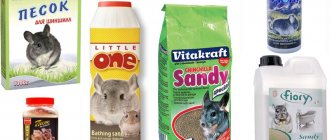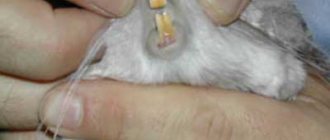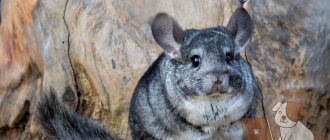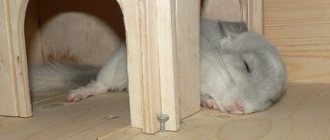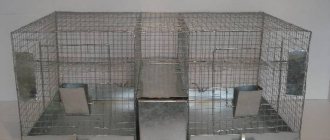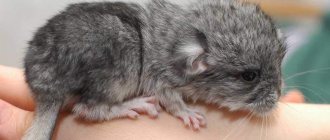In order to maintain the health, appearance and mood of the animal in good condition, constant care for this unique animal is necessary. Care consists not only of proper nutrition and providing the pet with a spacious home, but also of keeping the chinchilla’s dense, thick fur clean, helping the animal to bathe on time. This animal should be bathed in a special way, which is quite different from the usual bathing of cats or dogs.
Like any animal, a chinchilla needs to have its fur cleaned occasionally.
“Bath” procedures for chinchillas
Like any other animals, chinchillas need regular care. Their fur and body must be kept clean - and not only for the sake of beauty, but also for health. Maintaining hygiene is one of the factors for good health and longevity of a rodent.
Every chinchilla needs a bath
Why does a chinchilla need periodic bathing?
- after cleaning, the animal’s thick fur becomes soft;
- Stuck hairs are removed from the fur coat;
- excess moisture is removed from the body;
- The animal gets tremendous pleasure and relieves stress.
However, you should not indulge in frequent “bath” procedures: daily bathing of chinchillas is prohibited, and it is not necessary.
Review of popular bathing mixtures
Both domestic and foreign manufacturers offer many varieties of ready-made sand mixtures for bathing chinchillas. Let's look at the most popular manufacturers of sand for bathing chinchillas.
- Benelux . The basis of this bathing mixture is zeolite; it is a well-known and trusted manufacturer. Although the price is not high, it is also difficult to call this sand budget.
- Lolopets . Composition: volcanic dust and crushed quartz. One of the advantages is the low price.
- Mr. Alex . Affordable sand for bathing chinchillas based on crushed quartz. The package also contains talc in a separate sachet, which must be added before bathing.
- Waka . Produced in Russia. Base: a mixture of volcanic sand with crushed quartz. A sachet of talcum powder is also included. Owners of chinchillas in reviews of this mixture strongly recommend that you carefully inspect it after purchase, since large particles may be encountered that can injure the animal. If such particles are found, they should be removed. As for the price, it is quite affordable.
- Little animals . Mixture from a Russian manufacturer. Chinchilla owners write in reviews that at a very affordable price, this mixture, which includes talc, magnesite and chlorite, is quite good. It perfectly cleans the animal's fur without harming it.
- Padovan . Sand from this manufacturer is recommended for use by owners of chinchillas whose animals are kept in rooms where the humidity is above average. Because this mixture, made on the basis of zeolite with the addition of a number of minerals, has excellent performance in terms of absorption and moisture retention.
- Vitacraft . Products of a famous German manufacturer of pet products. Composition: sepiolite and other minerals. The mixture is very popular due to its relatively low price and good consumer characteristics.
- Little One . Made from several minerals of volcanic origin. Chinchilla owners note that the main advantage is the almost perfect balance of components, which allows for the best possible cleaning of the animal’s fur. A very noticeable disadvantage is the high cost.
Is it possible to bathe a chinchilla in water?
Beginning chinchilla breeders may not realize that swimming in water is strictly contraindicated for their pets. For these funny, cute fluffies, a bath with water is a fierce enemy. And not at all because they don’t know how to swim. This is all due to the physiological characteristics of chinchillas. The fact is that they completely lack sebaceous glands: during bathing, their thick fur coat gets completely wet, which can lead to hypothermia, and then to a cold in the animal.
Water is dangerous for chinchillas
Any veterinarian will confirm to you: water procedures are dangerous for chinchillas. You should resort to them only in exceptional cases, and you can only wet the fur locally.
FAQ
In order for your pet to enjoy bathing in the sand without damaging its fur and skin, it is necessary to pay due attention to the choice of bathing suit, sand and all additional accessories for washing the animal.
What you need to purchase for proper bathing of chinchillas
To wash your pet, you should purchase the most convenient container into which sand will be poured. This container must be, first of all, safe: without sharp corners and chips, and also easy to wash under water.
Most bathing suits come in two types: a small bath, which is placed in the animal’s house, or a separate terrarium, where the pet moves for half an hour to carry out hygiene procedures. The first option is considered the most convenient, but in this case the owner needs to clean both the bathing suit and the animal’s cage quite often. The good thing about the terrarium option is that the closed shape of the container will prevent sand from being scattered around.
List of necessary items for swimming:
- comfortable and safe swimsuit;
- special sand, for example, volcanic sand for bathing rodents;
- medical sulfur for fur disinfection. This product can be purchased at pet stores, but medical sulfur should be used less frequently: once every few months unless otherwise specified by the veterinarian;
- talc for shine and smoothness of wool.
You can choose suitable sand for washing your animal only from the assortment presented in pet stores . Ordinary river, sea, construction or any other sand will not be suitable for bathing your pet.
Choosing the right sand for chinchillas
When choosing a bulk filler for a bath, you should pay special attention to the quality and composition of the sand. Soft, safe sand will not scratch the skin of your hands, so you can check the quality of this product at home by lightly rubbing the grains with your fingers.
It is advisable to choose a product without quartz content. A good finished product, which is sold in pet stores, contains volcanic sand or related components: sepiolite, zeolite or soapstone.
The filler should absorb moisture and fat well.
DIY sand for chinchillas
Some owners prefer to use sand made by themselves. This is not difficult to do; it is only important to find a high-quality starting material - zeolite, which should be crushed into crumbs and calcined in the oven. If desired, you can add a little talc to the resulting bulk product.
Have you tried making sand yourself?
Why does a chinchilla eat sand?
Sometimes your pet will start eating sand for bathing, but there is nothing to worry about. The rodent does this to normalize the gastrointestinal tract, thus grinding food.
In some cases, this behavior may indicate that the pet does not have enough calcium. To replenish calcium, you can grind calcium tablets for rodents and give them a little at a time.
Additional ingredients for bathing sand
As additional ingredients in sand, you can use talc, which has a beneficial effect on the appearance of fur, as well as disinfectants, for example, medical sulfur. You can also use fungistop, which contains both sulfur and talc. The optimal dosage of fungistop for one standard bathing suit is 1 teaspoon.
It is highly not recommended to wash your chinchilla in water!
What to do if your chinchilla gets wet
If the pet gets wet, it should be removed from the water as soon as possible and wrapped in a towel that absorbs moisture well. The fur should be blotted regularly with a dry cloth.
All windows must be closed and air conditioners must be turned off. Any, even the slightest drafts should be avoided.
Periodically, the towel in which the animal dries needs to be replaced with a dry one.
You can try to dry the fur with a hairdryer, holding the device with warm air at a distance of 20 cm from the animal’s fur. If the animal is afraid of noise, turn off the hair dryer and dry the fur with a towel.
You should not let your pet into the cage before it is completely dry. During drying, the animal should not freeze.
Important. Chinchillas cannot swim, so staying in water for a long time is very dangerous for them.
What to do if your chinchilla doesn't want to bathe
Refusal to bathe may be a sign that the pet has not yet fully settled into the house. In this case, you need to give the animal more time to adapt. When the animal begins to carry out hygiene procedures, it should be praised for this with a piece of a healthy treat after washing.
If the animal suddenly stops using the bathing suit, this may indicate some health problems, so the chinchilla should be shown to a veterinarian.
Sometimes sand or a bathing suit is not suitable for your pet. You can try to replace the filler, as well as the washing container itself.
Important. You cannot force your pet to bathe.
How to properly wash a chinchilla with water?
Sometimes you have to resort to using water to clean the skin or individual parts of the chinchilla’s body from dirt. For example, if an animal gets its paws dirty while walking around the apartment, you can pour warm water into a bowl and wipe the contaminated areas with a damp swab or sponge.
The water should be such that it is comfortable for a person to hold his hand in it - that is, not too hot or cold. When treating with water, be careful not to wet the rodent's eyes and ears.
After washing, you should immediately wrap your pet in a warm, soft towel. To ensure that the washed chinchilla dries as quickly as possible, it is recommended to use a hair dryer. Put the device on the initial mode (the hair dryer should work quietly) and dry the fur thoroughly. This will protect the animal from hypothermia and colds.
When the fluffy is completely dry, take a comb and gently comb the fur of the animal so that there are no lumps left in it. At this point, the “bath” procedure can be considered complete.
Bathing suit
A bath for a chinchilla is a prerequisite for keeping it at home. If it is not there, the animal’s fur will become dirty, lumps will begin to form and an unpleasant odor will appear.
You can swim:
- Buy
- Do it yourself
Bathing suits are sold in almost every pet store or they can be ordered from online stores like Ozon. Their cost starts from 500 rubles. The bathing suit is a plastic container, which consists of two parts: a bottom and a lid. The lid should always be removable so that you can easily change the sand in it and completely disinfect it during general cleaning.
What characteristics should a swimsuit have:
- Closed top to prevent the chinchilla from throwing sand in different directions
- Opening lid to make it easy to clean the bathing suit and change the sand in it
- Safety. The hole should be large enough so that the chinchilla does not get stuck in it, and also that it does not have sharp edges.
To take sand, or rather dust baths, a chinchilla requires a special container - a bathing suit. If your pet bathes in an open container, sand will scatter not only throughout the cage, but also around it. Therefore, as a bathing suit, you need to choose dishes with high walls or use a container made of plastic or tin measuring 30x30x20 cm. A three-liter glass jar is also suitable for bathing purposes. Glass bathing suits are good because they make it convenient to watch your chinchilla taking a bath. In pet stores you can find various bathing suits made of plastic or ceramics (for example, a ceramic bathing suit with ears or a house-shaped design is convenient).
Whether or not to keep the bathing suit in a cage is up to you. It is best to store it next to the cage and transplant the animal there so that the sand is always clean. If you don’t have time to care for your pet and constantly change it into a bathing suit, then, of course, it is better to place it in a cage so that the chinchilla bathes itself when it needs it.
Sand baths
Traditional baths are contraindicated for chinchillas, but sand baths are what you need. Exotic rodents love to swim not in water, but in sand. This is how they are used to cleaning their fur and maintaining hygiene.
Chinchillas “swim” in the sand with pleasure
To keep the body clean, 1-2 sand baths per week are enough for the animal. It is also convenient that the owner does not need to do anything during the bathing process - chinchillas fall out in the sand themselves with great pleasure.
How to bathe a pet
Chinchillas are bathed without human assistance. All the owner needs is a container for sand and suitable filler. It is necessary to strictly control what chinchillas bathe in.
The contents of the tray should be changed regularly; the presence of boluses and wool in the substance is unacceptable. You can’t bathe a chinchilla in regular sand; it may contain impurities that are harmful to it.
A pet limited in entertainment uses sand baths not only for hygiene, but also as entertainment. Daily treatments can cause his skin to become dry.
It is undesirable for the tray to be constantly in the animal’s cage. It is not necessary to bathe your chinchilla often, and he may begin to use the mixture as a toilet. During play, she brings particles of filler, food and hair into the bath, which makes the sand unsuitable for repeated bathing.
The optimal frequency of bathing depends on the humidity in the room. If the hygrometer level remains within 40-50%, it is enough to provide the tray once a week. At elevated levels, it is advisable to carry out the procedure more often.
How to prepare a sand bath for a chinchilla?
To bathe your pet in a sand bath, you first need to prepare the bathing suit itself. This is a special container with a convex clasp lid with a hole on the side. The animal should fit freely in this container. By the way, if you suddenly don’t find a bathing suit on sale, a regular 3-liter jar will do (it needs to be placed on its side).
It’s good if the bathing suit fits into the cage - then you can carry out the procedures “without leaving home” (and many chinchillas are terrible homebodies). Otherwise, bathing can be done in the same bathroom.
Approximately 5 cm of bulk material (special sand) should be poured into the bathing suit. Then we launch the pet into the container and watch how it enjoys, rotating around its axis and thoroughly falling out in the sand. During the process of falling out, small grains of sand make their way between the fibers of the wool, cleansing them of dirt.
Satisfied animal in a bathing suit
Half an hour is enough for everything, otherwise the rodent begins to lose moisture, and the edges of its ears may dry out, as a result of which these places become bald.
Ways to bathe at home
Unlike many other pets, chinchillas cannot be bathed in water. The water method of cleansing is possible only in the most extreme cases, while the most acceptable and safe method is to clean the animal’s fur using a sand bath.
Important . The contents of the container with bulk bathing filler must be changed regularly.
Sand baths: frequency and duration of bathing an animal in the sand
Usually, rodents take sand baths with great pleasure, happily tumbling in them and rubbing their skin on the fine sand.
The frequency of this procedure should not exceed 2-3 times a week, and the optimal duration of bathing is about 30-45 minutes.
Prolonged or too frequent stay of the animal in a bath with sand can negatively affect both the appearance and beauty of the fur, and the condition of the animal’s skin, which will itch, itch and peel. It is for this reason that a container with sand should be placed only during bathing, and not left in the pet’s home on a permanent basis.
No special skills are required to bathe a chinchilla in the sand.
Step-by-step instructions for bathing a chinchilla in the sand
Bathing your pet in a sand bath usually does not require any special skills. All that is required from the owner is to place a bathing suit with clean sand in the animal’s home on time, and then, after a while, remove it from there.
Step-by-step instruction:
- pour a sufficient amount of special sand into the bathing container, approximately in a layer of 4 cm. The exact amount of the bulk product is determined based on the instructions on the packaging with sand;
- in the evening, the prepared bath should be placed in the pet’s cage, placing it away from food bowls;
- seeing a sand bath, the animal will rush to it and begin the bathing procedure, turning over in the sand;
- After about half an hour of active bathing of the pet, the bath must be removed from the cage and cleaned of hair and other adhering particles.
It is recommended to replace the sand at least every 10 baths.
Important. It is forbidden to pour regular sand into the bathing suit. For washing an animal, only special sand is suitable, which can be purchased at pet stores.
Why you shouldn't bathe your chinchilla in water
It is forbidden to bathe a chinchilla in water because of the characteristics of its fur: the skin of this animal is very dense and thick, such fur dries from moisture rather slowly, which negatively affects the condition of the pet’s skin. In addition, a wet animal can easily catch a cold, because thick, warm fur protects the rodent from drafts and cold.
Bathing an animal in water unless absolutely necessary is strictly prohibited. If the animal's fur begins to look dull and untidy for no reason, it is recommended to take the pet to the veterinarian. The external condition of an animal's fur indicates its health.
When and how to bathe a chinchilla in water
In some exceptional cases, bathing an animal in water is allowed. However, this should be done very carefully and quickly, making sure that the pet does not catch a cold.
An indication for washing in water is severe contamination of the pet's fur in a sticky or adhesive substance that cannot be cleaned using the sand method. In this case, the owner should take a cotton pad and moisten it in warm, clean water, after which the contaminated area is wiped with gentle and quick movements. When the dirt has disappeared, the wet area must be wiped with a dry cloth until completely dry.
Important. Do not rub your pet's fur or skin too much. All actions must be carried out with careful and gentle movements.
If your pet needs to be given a full bath, it is first important to make sure that the animal is not sick and will tolerate the procedure well.
The bathing process itself is as follows:
- Prepare two containers of warm water. Add a small amount of rodent shampoo to one container. The water should reach the pet’s face;
- place the animal in a container with soapy water and gently rinse the fur;
- move the pet into a container with clean water, rinsing off the shampoo;
- wipe the face with a damp cotton pad soaked in clean water;
- carefully wring out the fur and place the animal on a terry towel that absorbs moisture well;
- If the animal is not afraid of loud sounds, you can dry the fur with a hairdryer, setting it to the quietest setting. In this case, the stream of warm air must be directed from a distance of at least 20 cm;
- It is recommended to keep the animal under clothing until completely dry. This will help the animal calm down, dry out faster and not freeze. Do not let your pet into the cage until it is completely dry.
Important. All manipulations must be carried out quickly so that the animal does not freeze. While swimming, you need to constantly make sure that moisture does not get on your head and especially in your ears or eyes.
There are several types of swimsuits
How to choose sand for a bath?
Modern pet stores offer a large selection of filler. Popular brands include: Vaka, Lauron, Vitakraft, Beaphar, Mr. ALEX, Little One. These fillers contain sedimentary rocks that have antifungal and bactericidal properties. Thanks to this sand, harmful elements are eliminated and the unpleasant odor disappears.
But ordinary river or sea sand cannot be used. It may contain particles that can harm the chinchilla's delicate skin. Such natural material simply does not meet sanitary requirements. Therefore, stock up on store-bought products, especially since they are inexpensive.
What kind of sand is needed for bathing a chinchilla?
In the chinchillas' habitat, there is a lot of volcanic and other dust under their feet, so they bathe in it. There is no such dust in our area, and river sand should never be used. It contains many harmful components and is very hard, this will have a bad effect on the condition of the chinchilla's fur. It also does not absorb moisture and oil from the chinchilla's fur well, so the chinchilla will not be able to completely clean its fur.
In order for bathing to bring only benefits, you need to buy high-quality sand from a pet store that will meet all the requirements:
- Must have bactericidal properties
- Antifungal
- Good at absorbing dirt and odors
Bathing sand is quite cheap, usually it costs 500 rubles for 2 liters, which will last a long time for 1-2 chinchillas. It is sold in almost every pet store. The composition of sand usually includes spiolite, palygorskite, zeolite, quartz and clay additives.
To ensure that your chinchilla has enough sand in his bathing suit, you need to add about 5 centimeters of sand. It needs to be changed every 10 or 15 baths. If the sand looks dirty even after 5-7 baths, then it is better to change or clean it.
Features of sand procedures
The best time for swimming is evening. As evening approaches, the rodent is most active, and therefore sand cleaning will be more effective. You can take extra care of your chinchilla's fur if you add medical sulfur, crushed Fungistop or Nystatin to the filler - this is a good fungus prevention.
When a chinchilla bathes, a large amount of dust is generated.
Most likely, during the “bathing” process the room will be filled with dust. This is natural, because the animal spins in the sand, raising the smallest particles into the air. That's why the best place for this type of bathing is the bathroom. Or be prepared to wipe all surfaces in the room with a damp cloth and shake out dust from soft items.
As for sand, it can be reused. But for this it is necessary to remove debris from it. It is also recommended to add fresh material to the old one. The bath should be completely renewed every 10 procedures.
Remember: sand bathing for a chinchilla is as necessary as a comfortable cage and regular food.
DIY chinchilla bathing suit
If for some reason you cannot buy a regular bathing suit at a pet store, then you can make it yourself or take improvised containers. Many people think that making a chinchilla bathing suit with your own hands is difficult, but look at the examples below and make sure that absolutely anyone can make it.
What is suitable for bathing a chinchilla in the sand:
- Bathing suit made from a plastic water bottle. Anyone can make it, you just need to cut a hole into which the chinchilla will climb. The main thing is that the bottle is transparent. This bathing suit has another advantage: you can not wash it, but simply throw it away when it’s time to change the sand and make it from a new bottle. Make sure there are no sharp edges because the chinchilla will be very active and could get hurt.
- Fishbowl. An excellent solution, besides, you can find them used on Avito for only 100-200 rubles. The glass will last a long time, and it will be easier for the chinchilla to tumble in it due to the fact that the glass is very slippery.
- Any vessel, canister with round edges, which will be slightly larger in size than your animal
- As a bathing suit, you can use a transparent container, which will be slightly larger in size than a chinchilla.
- While your chinchillas are small, you can use a regular three-liter jar. Make sure that the chinchilla can easily fit into it and that there is enough space inside. If the jar turns out to be too small, then it is better to refuse it.
What to do if your chinchilla doesn't want to bathe
You can return the bath to the chinchilla enclosure no earlier than ten days after the birth of the offspring. The female teaches the young animals hygienic measures from the 14th day of life. She demonstrates by example how and what to do. By the twentieth day, babies are ready for independent bathing. Experienced chinchilla breeders note that many young chinchillas do not devote enough time to bathing, but this goes away with age.
By her example, a chinchilla mother teaches her kids about hygiene
If the breeder claims that the pet is already familiar with hygiene procedures, but at home he does not bathe in the sand, it means the animal has not had time to adapt to the new room.
- you can ask the breeder for sand, or a tray that retains the smell of a particular animal;
- replace the closed container with a low one so that the rodent does not feel anxious in a confined space;
- It is worth leaving the animal alone with the bath.
When trying to teach a chinchilla to bathe in the sand, it is unacceptable to force it into a tray, hold it there and knock it down. This can cause stress and, through fear, reinforce negative associations with the container and the owner.
Often a chinchilla does not want to bathe in sand because the substance is not suitable for it. If your pet does not show interest in the tray, you should try changing the type of filler, or purchasing a composition from another manufacturer.
If refusal of the tray is accompanied by apathy and loss of appetite, you should consult a veterinarian. This indicates physiological health problems.
To encourage your chinchilla to roll in the sand:
- You can repeat the word “bathe” to your pet animal in a gentle voice every time it runs into the tray;
- immediately after the procedure, treat you to your favorite treat.
Over time, your pet will understand the relationship between the sound of the word, its actions and the reward. A patient owner can teach a rodent to bathe upon verbal invitation.
Features of a chinchilla cage
On sale you can find various options for cages and specialized display cases for chinchillas. They all have a number of differences between themselves.
Dimensions
A chinchilla cannot be called a calm animal, so in order for the animal to be active, it is necessary to choose the right size of the cage. There should be enough space for the animal to run and jump freely. The minimum cage sizes for keeping different numbers of animals will be as follows:
- for one chinchilla - 80x65x50 cm;
- for a pair of chinchillas - 90x90x50 cm;
- several animals - 100x70x50 cm.
Materials
Galvanized mesh and metal are used in the production of cages. Trays in cages and additional accessories (drinkers, feeders) are made of plastic, as it is less susceptible to moisture. Various protruding parts should be avoided, as the animal can gnaw them, and this often becomes the cause of various diseases.
Shelves made of plastic with metal edging are very convenient to use, they are easy to clean and last a long time. But if the plastic is slippery and smooth, then the animal may get injured. It is better to give preference to rough surfaces made of natural materials.
It is also worth paying attention to the bars in the cage. The distance between them should not be more than 2.5 cm, otherwise the chinchilla may damage its paws while moving around the cage. For females with offspring, this distance should be even smaller - 1.5 cm
The rods should not be too thin, the permissible width is from 1.5 mm
For females with offspring, this distance should be even smaller - 1.5 cm. The rods should not be too thin, the permissible width is 1.5 mm.
In addition to cages, chinchilla owners often choose special display cases as a home for the animal. They are made of wood and plexiglass. Such materials are safer for chinchillas, but caring for them poses a number of difficulties.
Wood, unlike plastic and metal, quickly absorbs odors and cannot be disinfected. However, chinchillas are very fond of wooden houses; they can sharpen their teeth on wood.
Many modern display cases for chinchillas are made of plexiglass with an aluminum frame. For such houses, sheets of plexiglass with a width of 6 mm or more are used; the edges must be processed so that the animal does not get hurt.
Cells can be disassembled or intact
Design
By design, chinchilla cages can be dismountable or solid. The main advantages of collapsible cages are as follows:
- they are easy to transport;
- convenient to store;
- just carry out disinfection.
The main disadvantage is that all the constituent elements of the cage are not tightly fixed to each other, unlike a solid structure. Because of this, a loud noise is heard when the chinchilla is active.
Many models are equipped with a retractable tray, which makes cleaning much easier. Often such pallets are covered on top with a second mesh bottom. The garbage immediately passes through the mesh and ends up in the tray, but the animal can get its paws stuck in such a mesh and get injured trying to get out of it.
Cages equipped with wheels are very convenient to use. Debris regularly appears around the cage and cleaning will require constant moving of the cage. It is much more convenient to do this on wheels, but you need to take care of the stability of the structure.
Showcases take up more space than cages, but have good sound insulation.
Which house is better?

